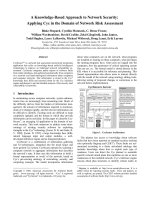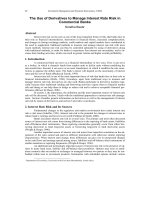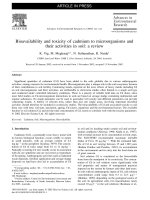Rock samples of pebble to cobble size are used in the every pebble tells a story activity
Bạn đang xem bản rút gọn của tài liệu. Xem và tải ngay bản đầy đủ của tài liệu tại đây (3.61 MB, 33 trang )
Every Pebble Tells a
Story 1
L. Braile, Purdue University
S. Braile, Happy Hollow
School, West Lafayette, IN
March, 2006
NSTA, Anaheim, 2006
,
/>
Last modified March 13, 2006
The web page for this document is:
/>This PowerPoint file: />Partial funding for this development provided by the National Science Foundation.
Copyright 2005. L. Braile. Permission granted for reproduction for non-commercial uses.
1
Objectives:
Make inferences about the
geological history of a pebble
by observing its characteristics
and by utilizing geological principles
and concepts. The Every Pebble
Tells a Story* activity is an excellent
follow-up to the study of mineral
and rock identification. However,
extensive experience with mineral
and rock identification is not required. This activity provides practice
in observing and critical thinking and opportunities for sketching and
creative writing. Because students select, analyze and write about
their own pebble, we have found that the activity is very engaging for
students. Additional materials (http://
web.ics.purdue.edu/~braile/edumod/pebble/pebbleAM.htm) that
accompany this activity include resources for the teacher, for helping
the student with the interpretation of their rock sample, and for
mineral and rock identification.
Rock Samples of
pebble to cobble
size are used in
the Every Pebble
Tells a Story
activity.
Limestone
Sandstone
Quartzite pebbles
Basalt
Pebbles with cross-bedding
Conglomerate
Mineral identification is an excellent preparatory
exercise for the Every Pebble Tells a Story activity.
Quartz
Hematite
Olivine
As a practice or review exercise, try to identify one or
more mineral samples.
1. List two distinctive properties of your mineral
sample.
2. Use the following Mineral Identification Flowchart
to identify your mineral sample.
3. What is the name of your mineral sample?
An online mineral identification quiz can be found at:
/>
Mineral Identification Flowchart
Magnetic;
shiny blac k
Metallic
Luster
Magnetite
Silver
color
Nonmagnetic
Mineral
Identification
Flowchart
Gold
color
Harder than
steel nail
Poor
Cleavage
Nonmetallic
Luster; Dark
color
Softer than
steel nail
Sta rt here
Good
Cleavage
Harder than
steel nail
Good
Cleavage
Poor
Cleavage
Cleavage
Softer than fingernail
Gr aphite
Reddish brown s treak
Hem atite
Harder than f ingernail,
dense
Galena
56 o and 124 o angle s
Am phibole
(hornblende)
87 o and 93 o angles
Pyroxene
(augite)
Well-f ormed crystals
No c rystals, glassy,
olive green
Nonmetallic
Luster; Light
color
Softer than
f in gernail
Cubic
cleavage
Gar net
Olivine
One direction, sheets
Biotite
m ica
Reddish brow n streak
Hem atite
Striations (tw inning)
Plagioclase
feldspar
No s triations (tw in ning)
Or thoclase
feldspar
No
cleavage
Softer than
steel nail,
harder than
f in gernail
Pyrite
Quartz
Halite
Pow der reacts with HCl
Dolom ite
Sample reacts w ith HCl
Calcite
Good
Cleavage
Thin sheets
Muscovite
m ica
Thick sheets
Gypsum
(selenite )
Poor
Cleavage
“Greasy ” feel
Talc
“Nongreasy ” feel
Gypsum
(alabas ter )
Non-cubic
cleavage
(modif ied from D.J. Thompson,
Basic Geology: Lab Manual , Allegheny Press, 1986; and
D.J. Conte, D.J. Thompson and L.L. Moses, Earth Scienc e - A Holistic Approach, W.C.
Pebbles for
“Every Pebble Tells a Story”
activity
Observing pebble features
1. The Rock Cycle: The rock cycle schematically illustrates the
processes of rock formation through surface and internal
processes (represented by the blue and red arrows) in the Earth.
Most of these processes, especially at large scale, are the
result of plate tectonics.
As the diagram shows, sedimentary rocks are formed by
erosion and deposition (and subsequent compaction and
cementation of the sediments into rock; usually by burial by
additional accumulation of sediments) of igneous,
metamorphic and previously-existing sedimentary rock by
surface processes (mechanical and chemical erosion by
wind and water).
Igneous rocks are formed by melting (and subsequent
cooling and crystallization into solid rock) of sedimentary,
metamorphic or pre-existing igneous rocks. Because the
melting point of typical Earth materials ranges from about 600
and 1300 degrees Celsius, the molten material that forms
igneous rocks comes from depths in the Earth where these
high temperatures exist (tens to hundreds of kilometers).
Volcanic igneous rocks are the result of liquid rock materials
(called magma; molten rock; or lava, when it reaches the
surface) rising from depths within the Earth (typically 20 to
150 km depth or more) and erupting on the surface where
they cool rapidly.
Metamorphic rocks are formed by re-crystallization (without
large scale melting of the material) caused to heat and pressure,
of sedimentary, igneous or pre-existing metamorphic rocks.
Metamorphic processes occur at depths of a few kilometers
below the surface to a many tens of kilometers depth. Because
igneous and metamorphic processes occur at significant depth
within the Earth, the exposure of igneous and metamorphic
rocks at the surface means that these rocks have been uplifted
to the surface after formation, often by plate tectonic processes.
Common surface sedimentary processes and rock
characteristics:
a. Mechanical and chemical erosion
b. Rounding of rock fragments and particles
c. Sorting of sediments during transport
d. Deposited in distinct layers.
e. Mineral sorting
f. Chemical sedimentary rocks (precipitation)
g. Clastic sedimentary rocks
contain rock or mineral
fragments.
h. Veins, weathering,
staining.
Common igneous processes and rock characteristics:
a. Melting, subsequent cooling resulting in crystals of distinct
mineral types.
b. Plutonic igneous rocks often show a “salt and pepper”
appearance and interlocking crystals.
c. Volcanic igneous rocks often have gas bubbles (vesicles)
visible.
d. Plutonic igneous rocks often
contain xenoliths.
e. Volcanic igneous rocks often
include phenocrysts.
Common surface metamorphic processes and rock
characteristics:
a. Metamorphic rocks are igneous, sedimentary or previouslymetamorphosed rocks that are transformed into new metamorphic
rock by heat and pressure; the heat and pressure cause recrystallization of the original minerals in the parent rock and
development of metamorphic texture.
b. Metamorphic textures are alignment of rectangular, platy, and
elongated crystals; development of shiny surfaces by the
conversion of clay minerals to mica; the generation of metamorphic
layering called foliation
(“wavy” layering); injection of minerals
(usually quartz and feldspar) in veins
and dikes that often cut across the
foliation; and the development of large
crystals (called porphoroblasts, such
as garnet or staurolite) in the
metamorphic mineral matrix.
Simplified Rock
Identification
and Origin
Flowchart
(designed
primarily to
determine the
origin of the rock
sample –
igneous,
sedimentary or
metamorphic).
Simplified Rock Identification and Origin** Flowchart
Simplified
Rock
Identification
and Origin
Flowchart
(designed
primarily to
determine the
origin of the
rock sample –
igneous,
sedimentary or
metamorphic).
Visible, coarse grain, foliation (wavy
layers), grains are aligned, often has “salt
and pepper” look, white “veins”, most
grains are harder than a nail
Coarse to fine grain, surface is shiny,
foliation (wavy or flat layers), softer than a
nail
Rock
has
layers*
Rock has distinct “sugary” look, layering
may be very subtle, cannot scratch off
grains, harder than nail, white to tan,
sometimes colored, may show cross
bedding
Fine grain, surface is not shiny, thin flat
layers, usually dark color
Grains are fragments (often rounded)
cemented together, can usually scratch off
grains
Very fine grain, looks “chalky” but is very
hard (harder than nail), can be any color,
layering may be very subtle
Start
Here
Rock
has no
layers*
METAMORPHIC, gneiss
METAMORPHIC, schist (coarse
grain), phyllite (medium grain),
slate (fine grain, less shiny,
thin flat layers)
METAMORPHIC, quartzite
SEDIMENTARY, may have
fossils, shale, mudstone
SEDIMENTARY, may have
fossils, siltstone, (fine grain),
sandstone (medium grain),
conglomerate (contains
rounded pebbles), breccia
(contains angular pebbles)
SEDIMENTARY, chert, flint
Soft***, reacts with acid, may
have fossils, usually light gray,
SEDIMENTARY, limestone
Fine grain, no crystals visible
Grains visible or many wavy
lines, METAMORPHIC, marble+
Visible interlocking grains (crystal shapes),
often “salt and pepper” appearance
Hard***, does not react with
acid, no fossils, usually dark
color, IGNEOUS, volcanic
Fine grain, no crystals visible, has vesicles
(holes, like gas bubbles)
Glassy, usually black
IGNEOUS, plutonic, may
contain xenoliths
Rock
has
layers*
Simplified
Rock
Identification
and Origin
Flowchart
(designed
primarily to
determine the
origin of the
rock sample –
igneous,
sedimentary or
metamorphic).
sometimes colored, may show cross
bedding
Fine grain, surface is not shiny, thin flat
layers, usually dark color
Grains are fragments (often rounded)
cemented together, can usually scratch off
grains
Very fine grain, looks “chalky” but is very
hard (harder than nail), can be any color,
layering may be very subtle
Start
Here
Rock
has no
layers*
fossils, shale, mudstone
SEDIMENTARY, may have
fossils, siltstone, (fine grain),
sandstone (medium grain),
conglomerate (contains
rounded pebbles), breccia
(contains angular pebbles)
SEDIMENTARY, chert, flint
Soft***, reacts with acid, may
have fossils, usually light gray,
SEDIMENTARY, limestone
Fine grain, no crystals visible
Grains visible or many wavy
lines, METAMORPHIC, marble+
Visible interlocking grains (crystal shapes),
often “salt and pepper” appearance
Hard***, does not react with
acid, no fossils, usually dark
color, IGNEOUS, volcanic
Fine grain, no crystals visible, has vesicles
(holes, like gas bubbles)
Glassy, usually black
Fine grain matrix, distributed crystals
(phenocrysts) visible (usually rectangular)
IGNEOUS, plutonic, may
contain xenoliths
IGNEOUS, volcanic
IGNEOUS, volcanic, obsidian
IGNEOUS, volcanic
This flowchart is designed for commonly occurring rocks, especially those that are fairly resistant to erosion
(often igneous and metamorphic rocks) and are thus likely to be selected as pebbles for the Every Pebble
Tells a Story activity. A small percentage of volcanic rocks show small scale layering caused by flow lines;
these and other samples may not be correctly classified using this flowchart. Some samples show sedimentary
features but have been metamorphosed. Examples include metamorphosed conglomerate, quartzite and
greenstone (a metamorphosed volcanic rock). * “Has layers” means thin layers in hand specimen. ** Rock
type and most recent origin of the rock (igneous, sedimentary, metamorphic) is inferred from the flowchart
and can be interpreted in relation to the Rock Cycle. *** “Hard” means hardness of >5; “soft” means
hardness <5. + Scratch marble with nail to obtain powder; will react with acid.
Rock Identification Flowchart
Rock has
layers
Layers are
thin; shiny
Rock is
light colored**
Rock has
layers
Rock is often hard*
Gneiss (M)***
Coarse grained; often soft*
Schist (M)
Fine grained; often soft*
Phyllite (M)
Soft*; usually white, pink
or tan
Hard*
Rock has
no layers
Rock is
dark
colored**
Start here
Rock
Identification
Flowchart
Rock has
crys tals
(“coars e
grained”)
Layers are
wide bands
Fine grained matrix
Rhyolite (I)
Coarse grained
Granite (I)
Fine grained matrix; black, dk gray
Light gray
Basalt (I)
Andesite (I)
Med. grained; black, gray, greenish
Diabase (I)
Coarse grained; “salt and
pepper” appearance
Diorite (I)
Coarse grained; black, gray,
greenish
Sand grains visible; feels like sandpaper
Cannot scrape off sand grains, “sugary”
Thin, flat layers; greenish,
No sand grains
gray, red; smooth
visible; very fine
grained
Thin, wavy layers , looks
like mudstone
Rock has
no crys tals
(“fine
grained”)
Rock has
holes
(vesicles)
Rock has
no layers
Rock has
no holes
* “Hard” means hardness of
~5 or greater; “soft” means
hardness of less than 5.
** Dark colored means light
gray or darker.
*** I = Igneous rock ; S = Sedimentary rock ; M = Metamorphic rock.
Marble (M)
Gabbro (I)
Sandstone (S)
Quartzite (M)
Slate (M)
Shale (S)
Light colored**; low dens ity;
looks like a glassy s ponge
Pumice (I)
Dark
Glassy; like cinder
colored**
Not glassy, black, gray
Light gray
Scoria (I)
Glass; black, black with white,red
Obsidian (I)
Contains
pebbles
Can scrape
sand off rock
Not
glass
No pebbles
Hard*
Cannot scrape
sand off rock
Black,dk gray
Light gray
Various colors;
“sugary”
Various colors;
dull s mooth
surface
Soft*; usually
gray, white or tan
Basalt (I)
Andesite (I)
Conglomerate (S)
Sandstone (S)
Basalt (I)
Andesite (I)
Quartzite (M)
Chert (S)
Limestone (S)
I. Principle of Superposition (for relatively undeformed sedimentary
and volcanic rock layers)
A.
Time
B.
C.
2
1
Cross section view
Surface
D.
4
3
2
3
2
1
1
1
“Younger rocks are on top of older rocks.”
II. Principle of Original Horizontality
A.
B.
3
2
3
2
1
Time
C.
3
2
1
1
“Most layers of sediment are deposited in nearly horizontal layers.
Thus, layers that are now dipping were (most likely) deposited
approximately horizontally and then deformed.”
III. Cross-cutting relationships and Unconformities
A.
D.
B.
3
2
1
1
3
3
2
1
4
3
2
6
2
1
E.
3
2
1
Time
C.
3
53
2
3
2
2
1
1
1
7
3
2
6
1
F.
3
8
2
1
7
3
2
6
1
“Rock units, structures or surfaces representing erosion
and loss of continuous deposition (unconformities) that
cut across layers (cross-cutting) are younger than the
layers that are cut through.”
“An unconformity is a surface that represents a break in the
rock record, caused by erosion or non-deposition.”
IV. Cross-bedding
“A small scale (centimeters to meters) sedimentary structure
in which layers are inclined at an angle to adjacent layers.
Formed during deposition by currents of water or wind.”
Sample Reporting Pages:
An example of several of these steps for a particular rock sample is
shown below:
1. Observations and description (size, shape, smoothness, texture,
layering, colors, crystals or rock fragments visible, etc.) of your rock
sample (pebble):
- elongated, approximately oval shape; ~14 cm x 6cm x 3.5 cm
- has dark and light alternating layers, ~2 mm thick
- medium grain size (individual grains or crystals are visible)
- layers are slightly wavy (foliation)
- hardness of minerals is ~5 or greater
- surface is rounded and smooth
- white veins that cut across the layers are present
- some small cracks are visible
- a small piece was fractured off after the rounding
2. Sketch of your sample (annotate your sketch by pointing
out distinctive features or characteristics):









